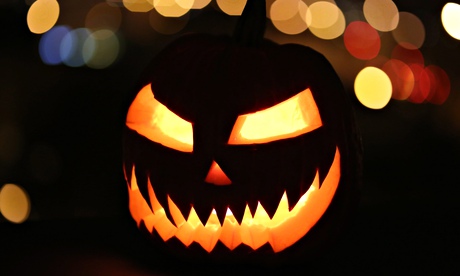
Halloween lit begins with two peculiar but seminal works in the debut collections of writers who would come to be hailed as founding fathers of their respective national traditions. Robbie Burns’s romping dialect poem “Halloween” (1786) is anything but frightening as spells are merrily cast while lads woo lasses in the now-bare cornfields – the mood seems more that of a boozy, libidinous late-summer party after the harvest than of an Ayrshire village hunkering down on the verge of November, fearful that hostile spirits will appear and cause havoc. Equally strange is Washington Irving’s story “The Legend of Sleepy Hollow” (1820), in which a superstitious New England schoolteacher, Ichabod Crane, is obsessed with rumours that a headless horseman is at large – and vanishes after encountering this soldier, who is either real or is Ichabod’s love rival, dressed up as a cruel prank. Although the tale’s Halloween credentials are impeccable (a pumpkin plays an important role), a cavalryman carrying his severed head was a distinctly unusual apparition in an era when the spirits believed to be liberated on All Hallows’ Eve were fairies and the souls of the dead.
For all their knotty oddity – or maybe because of it – the two works enjoyed remarkable after-lives. Burns’s poem is credited with keeping the folk customs it features alive through the 19th century, and with being the main advert for Halloween as Scottish and Irish immigrants brought it to the US (the three-day Catholic festival of the dead that it begins and Celtic Samhain – also on 31 October – were both foreign to New England and Virginia). Frequently adapted, Irving’s story became Tim Burton’s Sleepy Hollow (1999), with Johnny Depp as Crane, and is currently reworked in a US TV series of the same name; it can be seen as anticipating the 21st century’s multi-monster Halloween, just as Burns anticipates the mixture of fun and frissons of today’s trick-or-treating and bingeing on horror films.
After Burns and Irving (who conjured Sleepy Hollow while an expat in Birmingham), Britain’s contribution to Halloween lit all but vanishes for almost 200 years. Unsettling poems by the likes of Byron (“Darkness”), Coleridge (“Christabel”) and Christina Rossetti (“Goblin Market”) do get included in Halloween anthologies, but largely, you sense, to exploit their authors’ celebrity value: they are “suitable for Halloween” rather than genuinely connected to it. The more credible big-name inclusions – Edgar Allan Poe, Edith Wharton (“All Souls”), Sheridan Le Fanu (“The Child That Went with the Fairies”), WB Yeats (“Red Hanrahan”), James Joyce (“Clay” in Dubliners) – are noticeably either American or Irish. Presumably largely attributable to Protestant wariness – marking All Hallows’ Day, and hence All Hallows’ Eve, entails belief in purgatory – the apparent aversion of 19th- and early 20th-century British authors to the festival also took the form of reassigning their Halloween stories to one they did devoutly believe in. Dickens’s A Christmas Carol (like “The Haunted House”, a portmanteau story he supervised) centres on Spirits who belong on Halloween, and have nothing to do with Christmas or pagan Yule. MR James told his first autumnal ghost stories on 28 October 1893, but subsequently unveiled them to his students every Christmas.
By steering clear of this suspect Catholic or Celtic event, British writers were left behind in the 20th century as US genre authors profited from Halloween offerings, and as the array of spirits supposedly released came to include witches, vampires, zombies, werewolves and miscellaneous monsters. The festival became marked, too, by movies, special episodes of TV series, theme parks and merchandising promotions. Having imported Halloween from Europe in the previous century, the US now exported its commerce- and child-friendly version of it back to the old world.
Only in the 1970s and 80s did numerous authors in the UK begin, sheepishly, to realise sulking was silly and mimic their US counterparts by serving up horror, crime and children’s fare with Halloween tropes. It wasn’t until the 90s, though, that someone did more than play copycat. JK Rowling makes Halloween the occasion for significant events in the first four novels of her Harry Potter saga and, above all, the incident that shapes the entire cycle – Voldemort’s murder of Harry’s parents and attempted murder of Harry on 31 October 1981. Halloween is at last at the centre of a British fictional world, albeit not, perhaps significantly, an English one: Hogwarts is somewhere in Robbie Burns’s country, and the books were written in Edinburgh.

